Website owner: James Miller
SURFACES, SURFACE REPRESENTATION, SIMPLE SURFACE ELEMENTS, CURVILINEAR COORDINATES, SURFACE NORMALS, SURFACE CURVES, FIRST AND SECOND FUNDAMENTAL QUADRATIC FORMS, OSCULATING PARABOLOID, SURFACE AREA
Three common methods for the analytical representation of a surface. Three methods are commonly used to represent surfaces. They are
1] Surface representation 1. An equation of form
z = f(x, y)
where f is a single-valued continuous function defined on a region R of the xy-plane.
2] Surface representation 2. An equation of the form
f(x, y, z) = 0
3] Surface representation 3. Parametric equations of the form
x = f(u, v)
1) y = g(u, v)
z = h(u, v)
where f, g, h are continuous functions defined on a connected region R of the uv-plane.
Equations 1) of Surface Representation 3] do not necessarily map in a one-to-one fashion. That is, more than one point (u, v) may map into the same point (x, y, z). Because of this fact the “surface” produced by the system may sometimes be something quite different from the usual conception of a surface. To avoid this, a stipulation that it is one-to-one needs to be appended. We do this in the concept of a simple surface element.
Simple surface element. Let R be a simply connected region (i.e. a bounded region such as a rectangular or circular region without “holes”) of the uv-plane. Let equations
x = x(u, v)
y = y(u, v)
z = z(u, v)
define a bicontinuous one-to-one mapping of R onto a point set S in xyz-space. Let
![]()

be the position vector to point P on the surface and let the condition
![]()
hold for all points in R. Then S is called a simple surface element.
For brevity we will refer to a simple surface element using the notation S:
![]() .
.
A simple surface element may be viewed as any configuration which may be obtained from a rectangular plane region by continuous deformation (bending, twisting, stretching, shrinking) without tearing and without bringing any points together which were originally distinct. A simple surface element can be described as a patch of surface in space enclosed by a boundary — where the boundary points are images of the boundary points of region R under the mapping. Thus this excludes surfaces of infinite extent such as an infinite cylinder and closed surfaces such as a sphere or a torus. It includes such surfaces as a plane circular region or a hemispherical surface.
Any surface, however, be it a torus, sphere, cylinder or whatever, may be viewed as consisting of a collection of simple surface elements. That is, any surface can be divided up into regions viewed as simple surface elements.
Def. Class of a surface. Let S be a simple surface element defined by the one-to-one mapping
x = x(u, v)
1) y = y(u, v)
z = z(u, v)
of a region R of the uv-plane into xyz-space. The surface element is said to be of class C m if the defining functions 1) have continuous derivatives of the m-th order.
Curvilinear coordinates of a point on a surface. Given two coordinate systems, a u-v coordinate system and an X-Y-Z coordinate system. See Figure 1. The parametric equations
x = x(u, v)
2) y = y(u, v)
z = z(u, v)

assign a point (x, y, z) in the X-Y-Z system to each number pair (u, v) in the u-v system. The number pair (u, v) can be considered a set of coordinates for a point P(x, y, z). The numbers (u, v) are called the curvilinear coordinates of point P. If we regard v as fixed in system 2) i.e. v = c, a constant, then system 2) becomes a system in a single variable u describing a space curve where u is the varying parameter. For each different value of v there is a separate space curve. These curves are called u-curves. Similarly one can let u = k, a constant, and obtain a v-curve where v is the varying parameter. One thus obtains families of u-curves and v-curves. The u-curves and v-curves are called coordinate curves. These coordinate curves form a curvilinear net on the surface similar to the coordinate net on a plane. The locus of all these coordinate curves form the simple surface element S. See Fig. 1. In the figure
![]()
Property of being smooth. A surface is called smooth at a point P if it has a tangent plane at each point in the neighborhood of P, and if the direction of the normal to this plane varies continuously from point to point.
Theorem 1. Let S:
![]() be a simple surface element. Then at any point P on S
be a simple surface element. Then at any point P on S
![]()
![]()
where j1, j2, j3 are the following Jacobians:



Corollary.

Directions of surface normals. If a surface is smooth at a point it will have a normal at that point.. The directions of the normals are as follows:
Surface representation 1. z = f(x, y). The direction of the normal at a point P is given by the set of direction numbers
![]()
evaluated at point P. The surface is smooth at P if f has continuous first partial derivatives there.
Surface representation 2. f(x, y, z) = 0. The direction of the normal at a point P is given by the set of direction numbers
![]()
evaluated at point P. The surface is smooth at P if f has continuous first partial derivatives there.
Surface representation 3. Parametric equations of the form
x = x(u, v)
y = y(u, v)
z = z(u, v)
The direction of the normal at a point P is given by the vector
![]()
where
![]() is the position vector of point P i.e.
is the position vector of point P i.e.

The direction of the normal at a point P is also given by the set of direction numbers
j1, j2, j3
where j1, j2, j3 are the Jacobians



evaluated at point P. The surface is smooth at P if the three Jacobians do not vanish simultaneously there or, equivalently, if
![]()
Surface curves. We pose a question. How does one represent a curve on a surface? Let S be a simple surface element defined by the one-to-one mapping
x = x(u, v)
3) y = y(u, v)
z = z(u, v)
of a region R of the uv-plane into xyz-space. Let
![]()

be the position vector to point P on the surface. How does one represent a curve on surface S? We do it as follows. We define a curve in the uv-plane by the parametric equations
4) u = u(t)
v = v(t) .
The mapping 3) then maps this curve onto the surface S. Substituting 4) into 3) gives us the equations of the curve as inscribed on surface S i.e.

or, in vector form,

Surface curve tangents. Let S:
![]() be a simple surface element and let P be a
point on S. Let
be a simple surface element and let P be a
point on S. Let
![]() at point P, where we are using subscripts to denote partial
differentiation i.e.
at point P, where we are using subscripts to denote partial
differentiation i.e.

Let C be any curve on surface S passing through point P. Then the tangent vector
![]() to curve C at
point P is given by
to curve C at
point P is given by

or, equivalently,
![]()
which shows that
![]() is a linear combination of the vectors
is a linear combination of the vectors
![]() and
and
![]() — which means that it lies in
the same plane as
— which means that it lies in
the same plane as
![]() and
and
![]() . Now the vectors
. Now the vectors
![]() and
and
![]() are tangent to the u- and v-coordinate
curves at point P and define the surface tangent plane at point P. Thus we see that all surface
curves passing through point P have, at point P, tangents which lie in the surface tangent
plane there.
are tangent to the u- and v-coordinate
curves at point P and define the surface tangent plane at point P. Thus we see that all surface
curves passing through point P have, at point P, tangents which lie in the surface tangent
plane there.
First and second fundamental quadratic forms of a surface. A space curve is completely determined by two local invariant quantities, curvature and torsion, as a function of arc length. In the same way a surface is completely determined by certain local invariant quantities called the first and second fundamental quadratic forms.
First fundamental quadratic form. Let S be a simple surface element defined by the one-to-one mapping
x = x(u, v)
y = y(u, v)
z = z(u, v)
of a region R of the uv-plane into xyz-space. Let
![]()

be the position vector to point P on the surface. The First Fundamental Quadratic Form is
![]()
where:
![]()
![]()
![]()
This form expresses the relationship between the differential of arc length ds for any curve on the surface S and the variables u, v, du and dv in the uv-plane. The quantities E, F and G are called the Fundamental Coefficients of the First Order of the surface. The form is positive-definite, meaning it is positive for all values of the variables.
Theorem 2. At any point P on the surface S:
![]()
![]()
Corollary. At any point P on the surface S:
![]() the unit surface normal is given by
the unit surface normal is given by

Second fundamental quadratic form. Let S be a simple surface element defined by the one-to-one mapping
x = x(u, v)
y = y(u, v)
z = z(u, v)
of a region R of the uv-plane into xyz-space. Let

be the position vector to point P on the surface and let
![]() be the unit normal to the surface at
point P. The Second Fundamental Quadratic Form is
be the unit normal to the surface at
point P. The Second Fundamental Quadratic Form is
6) ω = Ldu2 + 2Mdudv + N dv2
where

![]()
![]()
The quantities L, M and N are called the Fundamental Coefficients of the Second Order.
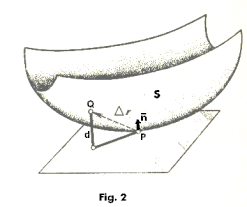
Physical interpretation of ω. Let P be the point corresponding to (u, v) and Q be the point corresponding to(u + du, v + dv) on surface S. See Fig. 2. Let d be the perpendicular distance from Q :(u + du, v + dv) to the plane tangent to S at P. Then d is equal to ½ω. Equation 6) gives ω as a function of the variables (du, dv) in a du-dv coordinate system. See Fig. 3.
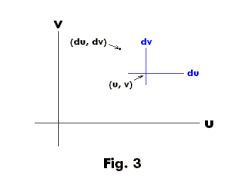
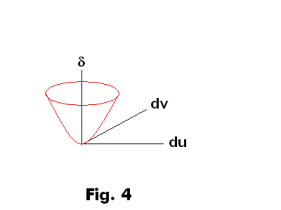
The values of d and ω can be either positive or
negative, depending on the direction in which the
unit surface normal
![]() is pointing. If
is pointing. If
![]() is
pointing in the direction of surface concavity
then d and ω will be positive. Otherwise they
will be negative. The direction in which
is
pointing in the direction of surface concavity
then d and ω will be positive. Otherwise they
will be negative. The direction in which
![]() points on a surface is something that is
arbitrarily chosen, a matter of choice.
Consulting Fig. 2, d is equal to
points on a surface is something that is
arbitrarily chosen, a matter of choice.
Consulting Fig. 2, d is equal to
![]() PQ, which
will be positive or negative depending on the
direction of
PQ, which
will be positive or negative depending on the
direction of
![]() . In the figure
. In the figure
![]() is pointing in
the direction of surface concavity and d is positive. The fact that the value of ω depends on
is pointing in
the direction of surface concavity and d is positive. The fact that the value of ω depends on
![]() can be seen from the fact that ω is a function of L, M and N which are dot products
containing the vector
can be seen from the fact that ω is a function of L, M and N which are dot products
containing the vector
![]() .
.
Theorem. The quantities L, M, N are also given by
![]()
![]()
![]()
Theorem 4. The Second Fundamental Quadratic Form is equal to
![]() i.e.
i.e.
![]()
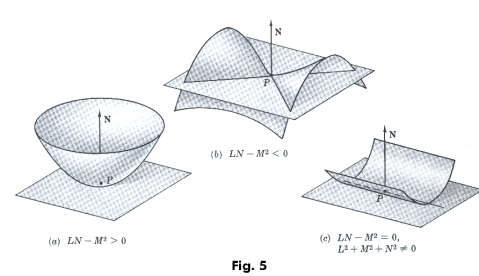
Osculating paraboloid at point P. The function
![]()
is called the osculating paraboloid at point P of the surface. The nature of this paraboloid determines the nature of the deviation of the surface from the tangent plane in the neighborhood of point P. If δ is plotted as a function of du and dv in a du-dv coordinate system (see figures 3 and 4) one will obtain one of four parabolic surfaces depending on the value the discriminate LN - M2 of the quadratic form Ldu2 + 2Mdudv + Ndv2. See Fig 5.
Case 1. LN - M2 > 0. Elliptic paraboloid. See Fig. 5(a). In this case the function represents a elliptic paraboloid and point P is referred to as an elliptic point. The surface lies completely on one side of the tangent plane.
Case 2. LN - M2 < 0. Hyperbolic paraboloid. See Fig. 5(b). In this case the function represents a hyperbolic paraboloid and point P is called a hyperbolic point. Here there are two lines in the tangent plane passing through point P which divide the tangent plane into four sections in which δ is alternately positive and negative. See figure. On the two lines, δ = 0.
Case 3. LN - M2 = 0 and the coefficients L, M and N are not all zero (i.e. L2 +
M2 + N2
![]() ). Parabolic cylinder. See Fig. 5(c). In this case the function represents a
parabolic cylinder and point P is called a parabolic point. Here there is a single line in the
tangent plane passing through P along which δ = 0. Otherwise δ maintains the same sign.
). Parabolic cylinder. See Fig. 5(c). In this case the function represents a
parabolic cylinder and point P is called a parabolic point. Here there is a single line in the
tangent plane passing through P along which δ = 0. Otherwise δ maintains the same sign.
Case 4. L = M = N = 0. Plane. In this case the degree of contact of the surface and the tangent plane is of higher order than in the other cases with the surface approximating a plane. Here point P is called a planar point.
Calculation of arc length, angles and surface area. The first fundamental coefficients E, F and G play a fundamental role in the calculation of arc length, angles and surface area on a simple surface element.
Arc length. Let S be a simple surface element defined by the one-to-one mapping
x = x(u, v)
8) y = y(u, v)
z = z(u, v)
of a region R of the uv-plane into xyz-space. Let
![]()

be the position vector to point P on the surface. Let
u = u(t)
v = v(t)
a
![]() t
t
![]() b define a curve in the uv-plane and let C be the image of this curve on surface S under
mapping 8). A point on the curve is thus given by
b define a curve in the uv-plane and let C be the image of this curve on surface S under
mapping 8). A point on the curve is thus given by

Length on curve C is then given by the integral
![]()

or, on expanding,

Angles between intersecting curves. Let two curves C1 and C2 issue from some point P on surface S with C1 given by the equations
u = u1(t)
v = v1(t)
and C2 given by the equations
u = u2(t)
v = v2(t) .
Then the tangents
![]() and
and
![]() to the two curves at point P are given by
to the two curves at point P are given by
![]()
![]()
Let
![]() be the angle between these two tangents. From the definition of a dot product it follows
that
be the angle between these two tangents. From the definition of a dot product it follows
that

Substituting equations 10) into 11) we obtain

Angle between u-curves and v-curves. Let β be the angle between the u-curve and the v-curve at some point P. From the definition of a dot product it follows that

From 13) we have the following theorem:
Theorem. The u-curves and v-curves are perpendicular at a point if and only if F = 0.
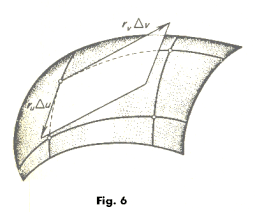
Surface area. To obtain a formula for area on
a simple surface element we consider a curvilinear rectangle bounded by the coordinate curves u
= u0, v = v0, u = u0 + Δu, v = v0 + Δv and use as an approximation to it the parallelogram lying in
the tangent plane and bounded by the vectors
![]() tangent to the coordinate curves. See
Fig. 6. The area of this parallelogram is
tangent to the coordinate curves. See
Fig. 6. The area of this parallelogram is
![]()
where f is the angle between
![]() and
and
![]() . Now
. Now
![]()
Substituting 15) into 14) and get
![]()
Now recall that
![]()
Substituting 17) into16) gives us
![]()
Now
![]()
Substituting 19) into 18) we have
![]()
Summing up the areas of the parallelograms and taking the limit as Δu, Δv
![]() 0 we obtain the
formula for area
0 we obtain the
formula for area
![]()
where the integration takes place over that domain D of the variables u and v that corresponds to the area of interest on surface S.
Alternate formulas for surface area. The following are two other equivalent formulas for surface area:
![]()
![]()
References.
1. Taylor. Advanced Calculus. Chapter 12.
2. Lipschutz. Differential Geometry. Chapter 9.
3. Mathematics, Its Contents, Methods and Meaning. Vol. II, Chapter VII.
4. Olmstead. Advanced Calculus. Chapter 18, 19.
5. Graustein. Differential Geometry.
6. Struik. Lectures on Classical Differential Geometry.
Jesus Christ and His Teachings
Way of enlightenment, wisdom, and understanding
America, a corrupt, depraved, shameless country
On integrity and the lack of it
The test of a person's Christianity is what he is
Ninety five percent of the problems that most people have come from personal foolishness
Liberalism, socialism and the modern welfare state
The desire to harm, a motivation for conduct
On Self-sufficient Country Living, Homesteading
Topically Arranged Proverbs, Precepts, Quotations. Common Sayings. Poor Richard's Almanac.
Theory on the Formation of Character
People are like radio tuners --- they pick out and listen to one wavelength and ignore the rest
Cause of Character Traits --- According to Aristotle
We are what we eat --- living under the discipline of a diet
Avoiding problems and trouble in life
Role of habit in formation of character
Personal attributes of the true Christian
What determines a person's character?
Love of God and love of virtue are closely united
Intellectual disparities among people and the power in good habits
Tools of Satan. Tactics and Tricks used by the Devil.
The Natural Way -- The Unnatural Way
Wisdom, Reason and Virtue are closely related
Knowledge is one thing, wisdom is another
My views on Christianity in America
The most important thing in life is understanding
We are all examples --- for good or for bad
Television --- spiritual poison
The Prime Mover that decides "What We Are"
Where do our outlooks, attitudes and values come from?
Sin is serious business. The punishment for it is real. Hell is real.
Self-imposed discipline and regimentation
Achieving happiness in life --- a matter of the right strategies
Self-control, self-restraint, self-discipline basic to so much in life